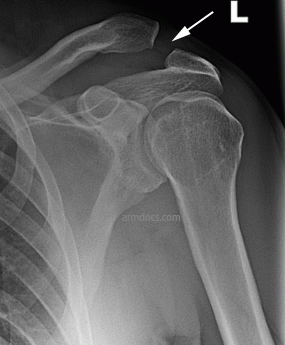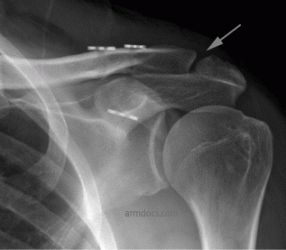How is the procedure performed?
The procedure is performed under a combination of general and regional anaesthesia. In the acute setting an incision is made over the acromioclavicular joint and the joint is exposed along with the outer end of the collar bone. Tunnels are drilled in the coracoid process and in the clavicle. A “Tight-rope” device is placed between the clavicle and the coracoid and tightened to stabilise the coracoclavicular interval. The capsule (or sleeve) around the acromioclavicular joint is repaired with sutures placed through drill holes in the bones. At the end of the procedure the overlying muscles are repaired and the skin is closed with sutures placed deep to the skin.
Benefits
The main benefit of the procedure is to repair the damage, restore stability and improve the function of the joint. More than 90% of patients achieve benefit from surgery.
Risks
Pain - The shoulder may be painful for some weeks after surgery. This is usually managed by taking appropriate pain relieving medication and activity modification.
Bruising – Bruising may occur around the joint and the scar and usually resolves 2-3 weeks after surgery.
Bleeding – A small amount of bleeding from the surgical wound is not unusual and will usually settle after a day or two.
Stiffness: This is uncommon following injury and surgery. In most instances it will resolve as you start moving the arm with the aid of physiotherapy.
Numbness around the scar: A small patch of numbness adjacent to the scar is not uncommon but does not cause any functional problems.
Asymmetry: A slight asymmetry between the two sides may persist. This does not usually cause functional problems.
Hardware or fixation failure – Rarely the sutures used in the tight-rope device may loosen, cut out of the bone or fail. This may require further surgery.
Infection – Infection is a possibility but is rare (1%). You will be given antibiotics as a precaution.
Nerve injury – This is possible but rare.
Arthrosis – Wear and tear in the joint following an injury may lead to symptoms at a later date and may require further treatment.
Aftercare
Following the procedure the surgical wound is covered with shower-proof dressings. The dressings should be left undisturbed as far as possible for 14 days. If the dressings are removed for any reason they should be replaced with similar dressings or waterproof plasters. Prior to discharge from hospital, a physiotherapist will provide instructions about looking after the shoulder. You will be advised to protect the shoulder by wearing a sling for 4 weeks and intermittently performing movements of the shoulder within certain limits. After 4 weeks you may stop wearing the sling and will be allowed to move the shoulder actively through a greater range. Strengthening exercises are started after 8 weeks. Vigorous use of the arm or lifting heavy objects should be avoided for 3 months. Outpatient physiotherapy will be arranged and may need to be continued for 3-6 months.
Resuming activities
You may resume driving at 1 week or when you have regained control of the arm. Return to work will depend on your occupation. Manual activities should be avoided for at least 3 months. Non-contact sports may be resumed at 3 months and contact sports at 6 months.
Follow-up
An appointment will be arranged for you to see Mr Patel at 2 weeks after the procedure. Follow-up is required for at least 12 months after surgery or until a satisfactory recovery is achieved.


